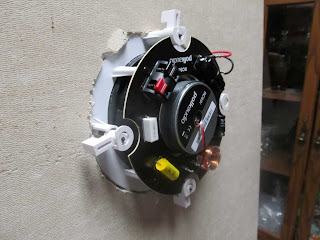Current System:
- Pioneer Surround Sound Receiver 100 watts x 5
- Front (A): Fisher 3 Way Speakers 12" Driver
- Sub: JBL 12" with 200 watt amp
- Patio (B): Yamaha Outdoor
- Center: JBL
- Surround: Polk RC60i (Ceiling Mount)
The basement in the house is roughly 1500 square feet of open space. The JBL sub can easily overpower a crowd, so we don't need more bass. If you're close the Fishers, the music is overbearing. We need to push more highs and mids to the back of the basement. Adding speakers is the ticket.
 |
| Polk RC60i - In Ceiling Speaker |
 |
| Use the template and a sharpie to draw the cutout. Believe it or not, a razor knife does the best job. |
 |
| The speaker has anchors that clamp the speaker to the tile. |
 |
| Mounted in ceiling |
A wiring run to the back of the basement needs at least 16 gauge speaker wire. You start losing sound if you go with small wire for a long distance. Also make sure the wire you use will fit into the speaker outlets. I ran the wire up the wall to the ceiling, following the same path as the cable TV coax.
 |
| 16 Gauge Speaker Wire About $12 |
Think it's a good idea to just plug a bunch of speakers into the B channel on your amp? Nope. Most amps are made to run speakers at 8 ohms. When you start hooking up more speakers to the same output, the ohms drop and your amp starts working hard to keep the sound going. Very similar to hopping on the exercise bike and cranking the resistance all the way up. You'd wear out quickly and pass out. If you're lucky, your $400 receiver will burn up. Unlucky, and it'll catch on fire.
Enter the Monster Cable SS4. This box supports 4 pairs of speakers and keeps the ohm rating safe for the amplifier. Amazon.com has these for about $60. Connect the box to the B speaker outlets on the receiver.
 |
| Monster Cable SS4 |
So now, I've got a new set of speakers in the back of the basement. The Monster box is driving the Yamaha patio speakers and the new Polks. What about playing music on the rear surround speakers? Well, that one took a little thought. My old school Pioneer receiver doesn't have a setting to change the rear surround speakers to regular music. When you push the surround sound button, movies in Dolby 5.1 come to life, but 2 channel (stereo) audio sounds like crap.
A little more searching online turned up a speaker selector switch made by Specialty-AV on Amazon.com, roughly $30. This is a little hard to explain, so you may want to slow down a bit. The box is really made to hook an amp up to two sets of speakers and select between the speakers. In my application, the flow is backwards. The rear surround speakers from the amp go into the "Pair 1" speaker outputs on the box and the "B" speaker outputs from the amp go into the "Pair 2" speaker outputs on the box. The inputs on the box go to the Monster box inputs. I use the box to drive all the speakers with either rear surround sound (for movies) or "B" outputs (for music) from the receiver.
 |
| Speaker switcher |
 |
| Both boxes all hooked up. Looks a little messy from the back |
 |
| Label the buttons and the job is finished |
This job was actually a lot of fun and only took a couple of hours. For a bit north of $220, the basement system can safely drive 4 pairs of speakers. We'll all be smiling at the next Halloween party.
If you're interested here's another article I wrote about hi-def TV's and soundbars: My not-so-$188 TV



























